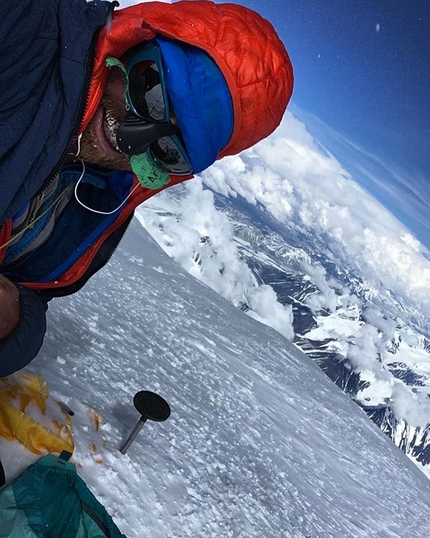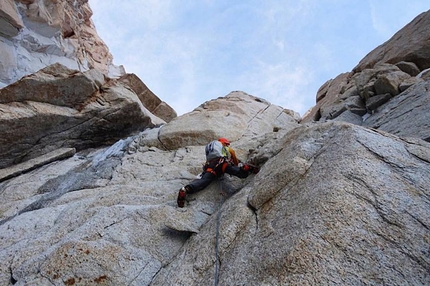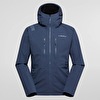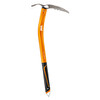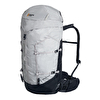Colin Haley completes first winter solo of Supercanaleta on Fitz Roy in Patagonia

 1 / 10
1 / 10 Colin Haley
Colin Haley
Chamonix-based alpinist Colin Haley has completed a climbing goal that has been playing on his mind for the last nine years, namely the first winter solo ascent of the Supercanaleta on Fitz Roy in Patagonia. The phenomenal 1600m climb up the mountain’s West Face is regarded as a natural masterpiece; first ascended in 1965 by the Argentineans Carlos Comesaña and José Luis Fonrouge, it embraces all styles of climbing (ice, mixed and rock) past difficulties up to 85°, 5+ and over the years has transformed into one of the biggest jewels in Patagonia’s lavish crown.
Before embarking on his solo Haley knew the route well. He first climbed the line in December 2007 with Maxime Turgeon, then completed only the second solo ascent of the Supercanaleta in January 2009 after Dean Potter had made the first in 2002. In 2016 Haley teamed up with Andy Wyatt to climb Fitz Roy in less than a day roundtrip from the road for the first time, requiring just 21 hours from the car and back.
Haley traveled to Patagonia this August and at the end of the month and start of September he made two trips into the mountains to stash climbing gear near the base of the route. He then approached the mountain on the 6th of September but reached the base late in the day due to the copious amount of snow and, after receiving an updated weather forecast, he returned to El Chalten the next evening. He made a second attempt on the 12th; he crossed the Bergschrund at 7:00am, but progress was slow due to hard, grey ice on the lower section. He reached the diagonal rappel above the Bloque Empotrado at 14:30 and after inadvertently bending his pick and knowing that a storm was approaching, he descended. The abseils proved arduous and while dodging falling rocks he vowed he would never try to solo the route again. He returned to the safety of his tent at 21:30, just a few hours before a major storm arrived. He packed all his gear and throughout the night made what he describes as an "epic" hike back to civilisation.
The thought of the Supercanaleta didn’t leave him though and on the 18th of September he was back again. He’d split the approach over two days due to the fresh snowfall and the fact that he had to transport all his gear to the base of the mountain once again. He felt fatigued and considered taking a rest day, yet after consulting Patagonian expert Rolando Garibotti - with whom in 2008 he’d made the coveted first Torre traverse - he opted to make his push on the 19th.
The 38-year-old crossed the Bergschrund at 7:00am once again and despite reaching his previous highpoint only 15 minutes earlier than before, this time he was slightly more confident because he knew the weather would hold. He negotiated dry terrain and after stashing one of his 60m ropes, he reached the upper southwest ridge at 15:45. He finished the last difficult pitch in last light at 20:05 and summited at 21:23. Anxious about the descent, he started downclimbing almost immediately and made a couple short rappels along the upper 200m of mixed terrain to reach the top of the huge gully. 1000 meters of rappelling followed, at first with just one rope for the first 200m, then with his second roped stashed in the gully. He returned to his tent at 5:00am on the 20th of September. Feeling “wasted physically, mentally, and psychologically” he rested for 12 hours, then started the walk out at 17:30. He bivied one last time, on dry ground between Piedra Negra and Piedra del Fraile, and returned to El Chalten on the 21st.
In his excellent report on his website, he sums up the experience as follows: "There is no one pitch on the Supercanaleta that is extremely difficult or dangerous, but the length of the route, having to be in a hyper-focused state non-stop for 21.5 hours, and doing it all in the cold and solitude of winter made it a very intense experience. It is difficult for me to gauge or quantify how much more difficult it was than soloing the route in summer back in 2009. For sure it was a significant step up, even though in 2009 I had particularly bad conditions for summer, and even though this time I had, I think, pretty good conditions for winter, and certainly good weather. It is also difficult for me to gauge, at least in my still-tired state, where this ascent stands among my other climbing accomplishments, or how this ascent will be viewed by others. I often find the public reaction to various climbing accomplishments to not correlate very strongly with the actual difficulty of the climbing accomplishment. These days what seems to count is making movies rather than making difficult ascents. It doesn’t matter really. I know from the intensity of my experience that it was pretty darn badass, and I don’t need external affirmation to confirm that to me."
Haley thanks Petzl, SCARPA, Patagonia



 Copia link
Copia link









 See all photos
See all photos